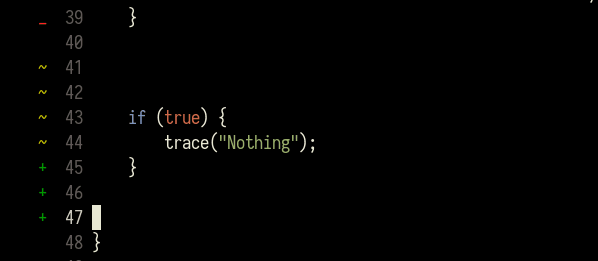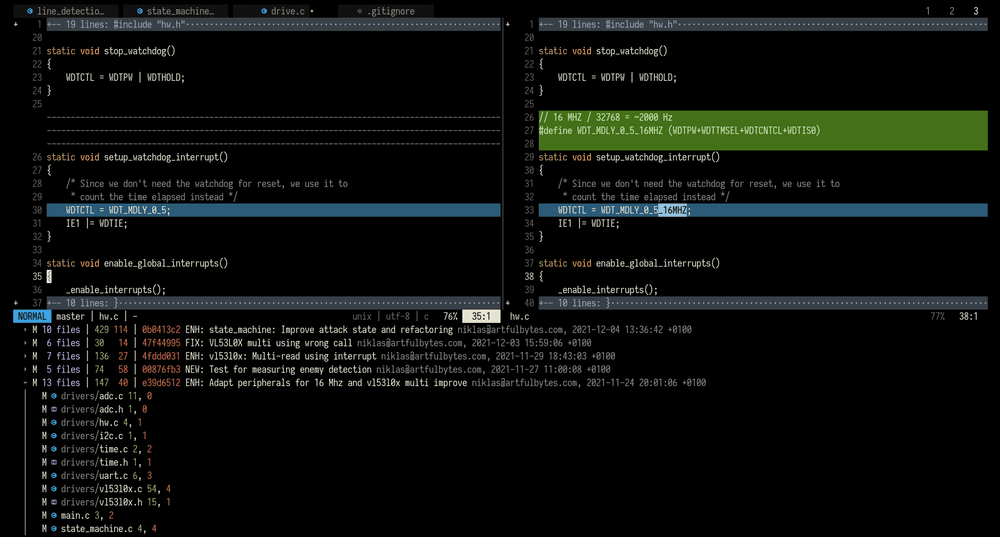A blog about building and programming hardware.
My development environment
On this page, you will find some notes about my development environment. Just as for any craftsman, tools help you do your job faster and better. As a software developer, it's about reducing the effort to take a solution from my head and translate it into code. Good software tools allow me to spend less time on mundane and repetitive tasks.

Summary
| Distribution | Ubuntu 20.04 (64-bit) |
| Window manager | i3 |
| Editor | Vim |
| Terminal | Alacritty |
| Browser | Firefox |
| Dotfiles manager | yadm |
| Status bar | i3blocks |
| Font | Iosevka |
| Image view | sxiv |
| PDF viewer | zathura |
| Program launcher | j4-dmenu-desktop |
| File manager | Nautilus |
| Media player | VLC |
| Login manager | gdm3 |
Rules
I want my development environment to be
- Easy to customize
- Easy to maintain
- Easy to setup (Ideally, a single command to set it up)
- Version-controlled (and documented)
- Keyboard-driven (I don't want to use my mouse)
- Suitable for embedded work (C/C++)
Linux
I've run Linux for almost ten years now. I can't see myself running any other operating system. Linux lets me customize my system to the way I want it; it allows me to automate the things that can be automated; and it provides me with the set of tools I need for working with software. Everything is organized neatly and follows principles that makes sense for a software developer. Moreover, knowledge of Linux is essential as an embedded engineer since so many embedded systems run it these days.
A computer is like air conditioning - it becomes useless when you open Windows.
- Linus Torvalds
Why I use Ubuntu
Even though I like setting up my system from scratch and knowing what software I've installed, I run the Ubuntu distribution, which is completely the opposite of that idea. The reason is that I also want my system to be easy to maintain. The bloat nags me, and I have the occasional urge to switch to Arch Linux, but Ubuntu's ease of use so far outweighs any reason I have to leave it.
Window manager: i3
I'm not a fan of stock Ubuntu, however, so I have tweaked it to the point of being unrecognizable from the stock environment. Partly inspired by Regolith Linux, I've replaced Ubuntu's floating window manager with i3, a tiling window manager. I launch i3 through a gnome-session by using i3-gnome-flashback to keep the system management capability of Ubuntu (e.g., display, wifi, key manager...). Together with i3, I use Picom (composite manager) for shadows and gaps, i3blocks as status bar, and j4-dmenu to launch programs.

A tiling window manager is a game-changer for anyone who likes a keyboard-driven workflow.
Editor: Vim
I use Vim (Neovim) as my main editor because I tried it out many years ago, it stuck with me, and it's hard to get out once you are in. I'm not sure Vim is worth the effort, and if I started today, I would seriously consider Visual Studio Code (VS code). Of course, as an embedded developer, I also find myself in IDEs that vendors "force" me to use.

Vim has been around for a long time, but it's still actively developed with a solid user base, especially since the release of Neovim, a fork of Vim that has propelled the development towards a better codebase with asynchronous features, Lua, language server support, and more. It's an exciting time to be using Vim.
You find my vim config here. In the following sections, I highlight the essential plugins I use. Note that my current config has most of what I need, but it's not perfect.
Language server: Coc
One defining feature of a good IDE is its capability to do auto-completion, linting, jump between definitions, and syntax highlighting. In the VS code vocabulary, this is referred to as IntelliSense. VS code achieves these features through language servers. What's nice about language servers is that they are separate from the editor, which makes it possible (and easy) to leverage the the same IntelliSense features in Vim.
There are several plugins to make Vim work with language servers; Neovim even has native LSP support nowadays, but I haven't made the move yet, instead, I use a plugin called Coc.nvim. In addition, I use the Clangd language server for C/C++ development.
Fuzzy finder: FZF and ripgrep
FZF (a command-line fuzzy finder) and ripgrep (a better grep) are two other must-haves for me. These two complementing tools make file and code navigation incredibly fast. Probably best demonstrated with an example:
There is also a popular (and supposedly better) fuzzy finder plugin called Telescope.nvim, which I haven't gotten around to try yet.
Version control: Fugitive, Gitgutter, diffview
Another central part of my workflow is Git. I have three plugins to integrate Git with Vim better.
gitgutter is the one I use the most. It appears as a left bar (a "gutter") with a symbolic summary of the modifications (hunks) made in the current file. It allows me to stage, undo and navigate between modified hunks quickly.

The second one I use is vim-fugitive, though so far, I only use its git-blame feature, but it has many other nice features I would like to try.

Finally, I use diffview to get a summarized view of individual commits.

Bootstrap and manage dotfiles
One area where Linux shines is automation, and a great example of this is that I can write a single "bootstrap" script to set up my entire development environment, which is exactly what I've done. A bootstrap script makes setting up a new computer easy. It also gives me a convenient way to version control my setup; Every time I make a new change, I commit it to my bootstrap script. You find this script in my dotfiles under .config/yadm/bootstrap.
Dotfiles manager: Yadm
My Linux setup relies on many configuration files, and to keep track of them, I use Yadm, a tool that lets you version control your dotfiles nicely with Git. By nicely, I mean it keeps the git repository separate from the home folder, and there is no need to system link files.
Font: Iosevka
As a programmer, you look at text all day, so you want a good font. I use the horizontally compact font Iosevka (Terminal Monospace) patched with Nerdfont (to get glyphs in Vim). If you are looking for a good font, you can use this website to compare popular programming fonts.